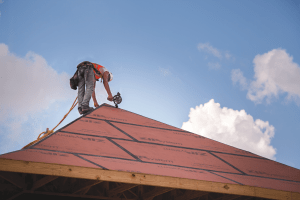Every year, severe storms endanger countless people and cause hundreds of millions — sometimes billions — of dollars in property damage. We want to better protect people and reduce the severity of damage by improving the way homes are built.

Many homes still use a traditional roof-building method of layering commodity roof sheathing, sheet-applied underlayment and shingles. This technique becomes problematic during storms when high winds begin stripping the roof of its shingles and underlayment, leaving the roof sheathing without a weatherproof barrier and rendering the home below highly vulnerable to water damage.
Building resilience, especially for increasingly common weather events, is crucial to protect the investment of a home. To achieve this, we recommend starting with these three methods, both for individual builders and the industry as a whole:
- Better communication. Today, people across the country have greater access to information. Cell phones, cameras, TVs, computers and other technology enable the immediate transfer of information, including the emotional impacts of large-scale natural disasters. As the full impact of these events is increasingly understood and more visible from multiple perspectives — human health and safety, economic, environmental and others — the impetus to find solutions becomes more urgent. Sharing new technologies and building methods across a fragmented industry is a challenging yet manageable next step.
- Better building innovation policy. Especially for those who live in regions where natural disasters are more common, it is critical to help home owners protect against water intrusion and damage. Appropriate building code provisions must be drafted and adopted. This foundational step will influence design, construction and inspection/commissioning of new buildings.
- Better building envelopes. At Huber Engineered Woods, we developed ZIP System® building enclosures. Our roof and wall systems are composed of engineered wood panels with an integrated water-resistive barrier sealed with high-performance tape and liquid flashing products that streamline air and water management. In roof applications, this integrated sheathing and tape system creates a sealed roof deck, resisting loads experienced during high wind events while managing bulk water and air movement.
The combination of a built-in water-resistant barrier and taped-panel seams on a high-strength engineered wood panel not only eliminates the need for a sheet-applied underlayment, but also creates a dependable, water-resistant deck that can protect a roof from damaging water intrusion in the event high winds blow off roof coverings.
After one of the hurricanes last year, there was widely publicized imagery of single buildings standing amid miles of complete destruction. At a fundamental level, this sends a clear message — we have the capability to build highly resilient structures.
Education and outreach are critical to changing behaviors and expectations about building performance. At Huber Engineered Woods, we have found that insufficient education is often the greatest barrier to success. We look forward to learning and contributing new information about building science innovations with the industry.

